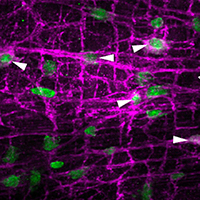Effect of TNBS-induced colitis on enteric neuronal subpopulations in adult zebrafish

Submitted: 15 July 2020
Accepted: 24 August 2020
Published: 28 August 2020
Accepted: 24 August 2020
Abstract Views: 1350
PDF: 899
HTML: 10
HTML: 10
Publisher's note
All claims expressed in this article are solely those of the authors and do not necessarily represent those of their affiliated organizations, or those of the publisher, the editors and the reviewers. Any product that may be evaluated in this article or claim that may be made by its manufacturer is not guaranteed or endorsed by the publisher.
All claims expressed in this article are solely those of the authors and do not necessarily represent those of their affiliated organizations, or those of the publisher, the editors and the reviewers. Any product that may be evaluated in this article or claim that may be made by its manufacturer is not guaranteed or endorsed by the publisher.
Similar Articles
- M. Aita, F. Benedetti, E. Carafelli, E. Caccia, N. Romano, Effects of hypophyseal or thymic allograft on thymus development in partially decerebrate chicken embryos: expression of PCNA and CD3 markers , European Journal of Histochemistry: Vol. 54 No. 3 (2010)
- V Benagiano, D Virgintino, P Flace, F Girolamo, M Errede, L Roncali, Choline acetyltransferase-containing neurons in the human parietal neocortex , European Journal of Histochemistry: Vol. 47 No. 3 (2003)
- Antonella Vetuschi, Alfredo Cappariello, Paolo Onori, Eugenio Gaudio, Giovanni Latella, Simona Pompili, Roberta Sferra, Ferroptosis resistance cooperates with cellular senescence in the overt stage of nonalcoholic fatty liver disease/nonalcoholic steatohepatitis , European Journal of Histochemistry: Vol. 66 No. 3 (2022)
- R.J. BuÅ‚dak, M. Skonieczna, Å. BuÅ‚dak, N. Matysiak, Å. MielaÅ„czyk, G. Wyrobiec, M. Kukla, M. Michalski, K. Å»wirska-Korczala, Changes in subcellular localization of visfatin in human colorectal HCT-116 carcinoma cell line after cytochalasin B treatment , European Journal of Histochemistry: Vol. 58 No. 3 (2014)
- Xufei Wang, Yinlian Liu, Yongnian Zhou, Yang Zhou, Yueping Li, Curculigoside inhibits osteoarthritis via the regulation of NLRP3 pathway , European Journal of Histochemistry: Vol. 67 No. 4 (2023)
- Xinyu Xu, Jiayu Shi, Chuanwei Zhang, Lixin Shi, Yujie Bai, Wei Shi, Yuliang Wang, Effects of artificial light with different spectral composition on eye axial growth in juvenile guinea pigs , European Journal of Histochemistry: Vol. 67 No. 1 (2023)
- K. Fujikawa, T. Yokohama-Tamaki, T. Morita, O. Baba, C. Qin, S. Shibata, An in situ hybridization study of perlecan, DMP1, and MEPE in developing condylar cartilage of the fetal mouse mandible and limb bud cartilage , European Journal of Histochemistry: Vol. 59 No. 3 (2015)
- E.P. Carvalho-Filho, A.C. Stabile, E. Ervolino, M.B.S. Stuani, M.M. Iyomasa, M.J.A. Rocha, Celecoxib treatment does not alter recruitment and activation of osteoclasts in the initial phase of experimental tooth movement , European Journal of Histochemistry: Vol. 56 No. 4 (2012)
- L. Fassina, G. Magenes, A. Inzaghi, S. Palumbo, G. Allavena, C. Miracco, L. Pirtoli, M. Biggiogera, S. Comincini, AUTOCOUNTER, an ImageJ JavaScript to analyze LC3B-GFP expression dynamics in autophagy-induced astrocytoma cells , European Journal of Histochemistry: Vol. 56 No. 4 (2012)
- R Pellitteri, A Zicca, GL Mancardi, T Savio, A Cadoni, Schwann cell-derived factors support serotoninergic neuron survival and promote neurite outgrowth , European Journal of Histochemistry: Vol. 45 No. 4 (2001)
<< < 9 10 11 12 13 14 15 16 17 18 > >>
You may also start an advanced similarity search for this article.

 https://doi.org/10.4081/ejh.2020.3161
https://doi.org/10.4081/ejh.2020.3161










